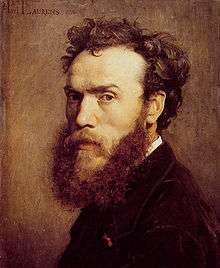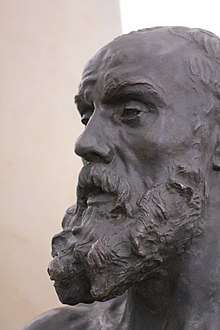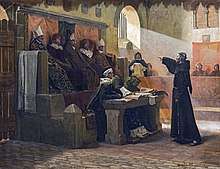Jean-Paul Laurens
Jean-Paul Laurens (28 March 1838 – 23 March 1921) was a French painter and sculptor, and one of the last major exponents of the French Academic style.
Jean-Paul Laurens | |
|---|---|
 Self-portrait | |
| Born | 28 March 1838 Fourquevaux, France |
| Died | 23 March 1921 (aged 82) Paris, France |
| Known for | Painting |

Biography
Laurens was born in Fourquevaux and was a pupil of Léon Cogniet and Alexandre Bida. Strongly anti-clerical and republican, his work was often on historical and religious themes, through which he sought to convey a message of opposition to monarchical and clerical oppression. His erudition and technical mastery were much admired in his time, but in later years his highly realistic technique, coupled to a theatrical mise-en-scène, came to be regarded by some art-historians as overly didactic. More recently, however, his work has been re-evaluated as an important and original renewal of history painting, a genre of painting that was in decline during Laurens' lifetime.
Laurens was commissioned to paint numerous public works by the French Third Republic, including the steel vault of the Paris City Hall, the monumental series on the life of Saint Genevieve in the apse of the Panthéon, the decorated ceiling of the Odéon Theater, and the hall of distinguished citizens at the Toulouse capitol. He also provided illustrations for Augustin Thierry's Récits des temps mérovingiens ("Accounts of Merovingian Times").
Laurens was highly respected teacher at the Académie Julian, Paris, and a professor at the École nationale supérieure des Beaux-Arts in Paris, where he taught André Dunoyer de Segonzac and George Barbier. He died in Paris, aged 82. Two of his sons, Paul Albert Laurens (1870–1934) and Jean-Pierre Laurens (1875–1932), both also became painters and teachers at the Académie Julian.
 The Release of the Prisoners of Carcassonne, 1879
The Release of the Prisoners of Carcassonne, 1879
 Saint John Chrysostom and Empress Eudoxia, 1893
Saint John Chrysostom and Empress Eudoxia, 1893 The Tournament, 1912
The Tournament, 1912
Notable students

- Moussa Ayoub[1]
- Marjorie Bates[2]
- Emilio Boggio
- Catharine Carter Critcher
- Georges Dufrénoy
- Ludwig Deutsch
- Jean Louis Aste (1864–1943)
- Sears Gallagher
- Kahlil Gibran
- Thomas Cooper Gotch
- Cecilia Cutescu-Storck
- Louise Herreshoff[3]
- Christian Herter of Herter Brothers
- Will Hutchins
- A. Y. Jackson
- Gustave Louis Jaulmes
- Alfred Garth Jones
- Leon Kroll
- Arturo Michelena
- Ella Ferris Pell[3]
- Cristóbal Rojas
- Robert Poughéon
- Paul Sibra
- René Schützenberger
- William Somerville Shanks
- Karl Yens
References
- "Ayoub, Moussa | Benezit Dictionary of Artists". www.oxfordartonline.com. doi:10.1093/benz/9780199773787.001.0001/acref-9780199773787-e-00009249. Retrieved 16 March 2020.
- Bates at Panvertu.com Archived 12 April 2019 at the Wayback Machine accessed 29 December 2007
- Eleanor Tufts; National Museum of Women in the Arts (U.S.); International Exhibitions Foundation (1987). American women artists, 1830–1930. International Exhibitions Foundation for the National Museum of Women in the Arts. ISBN 978-0-940979-01-7.
Further reading
- Desjardins, M. H. (2004). Des peintres au pays des falaises 1830–1940 (in French). Fécamp: Éditions des falaises. pp. 108–114.
- Jean-Paul Laurens 1838–1921, peintre d'histoire, Catalogue d'exposition, Musée d'Orsay (in French). Paris: RMN. 1997.
| Wikimedia Commons has media related to Jean-Paul Laurens. |